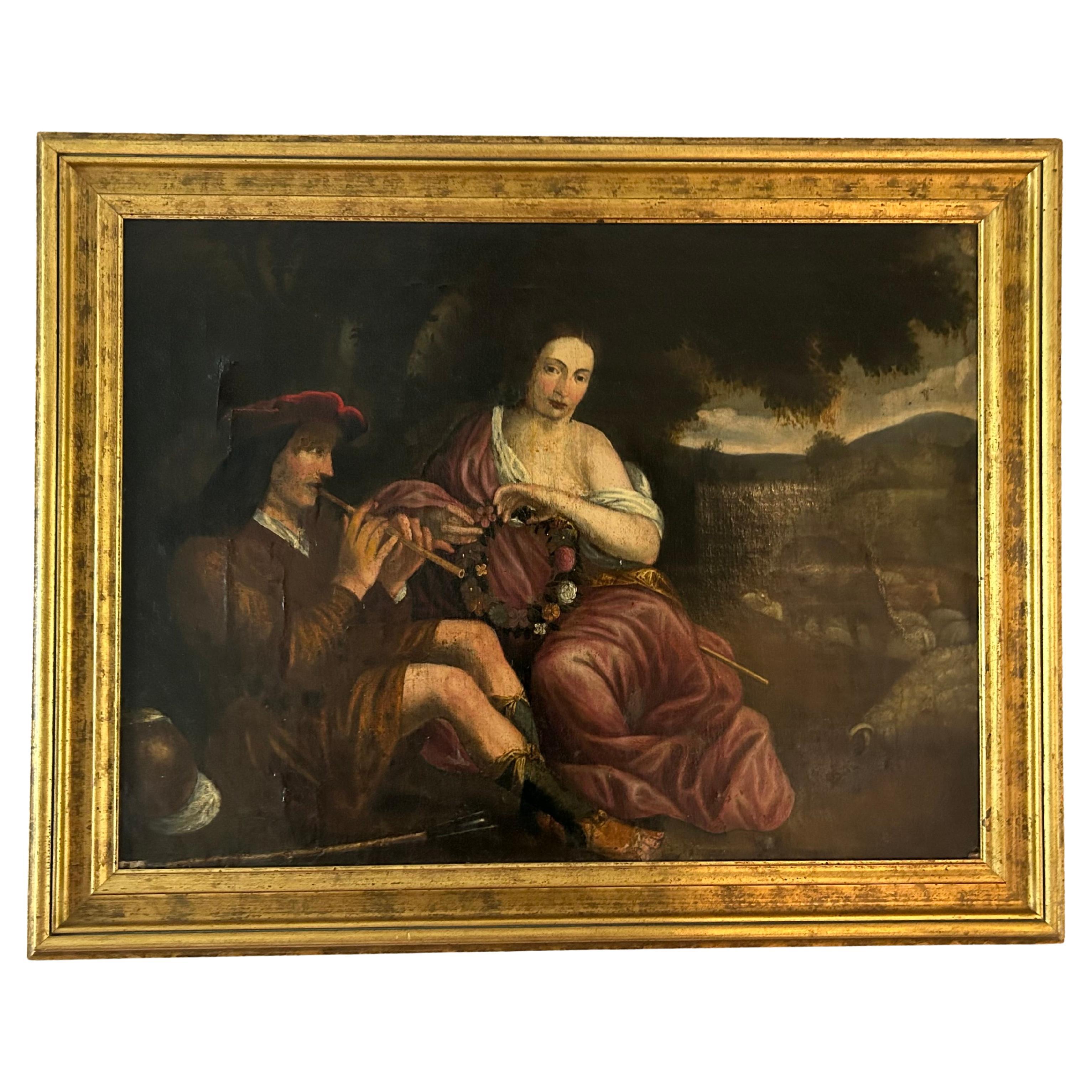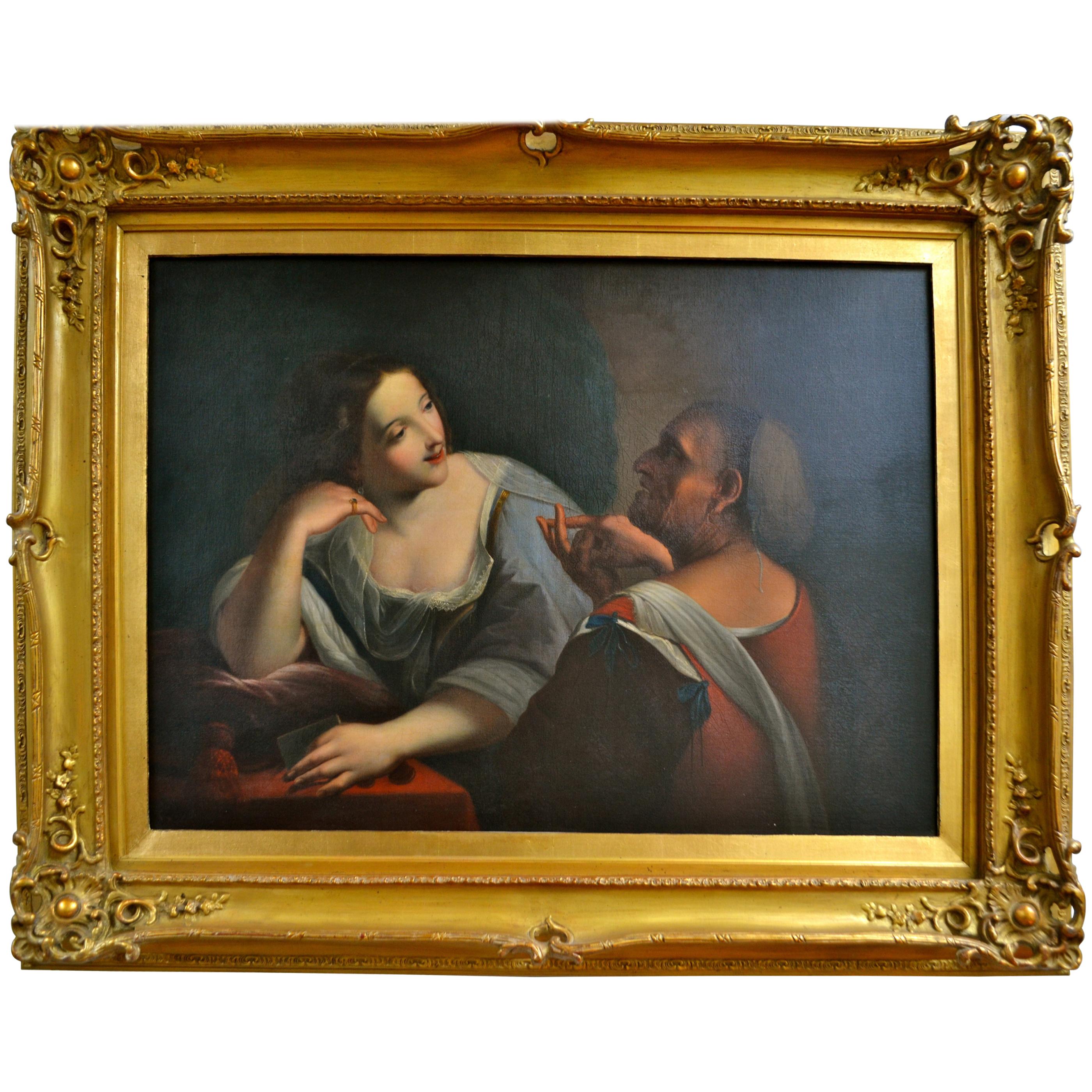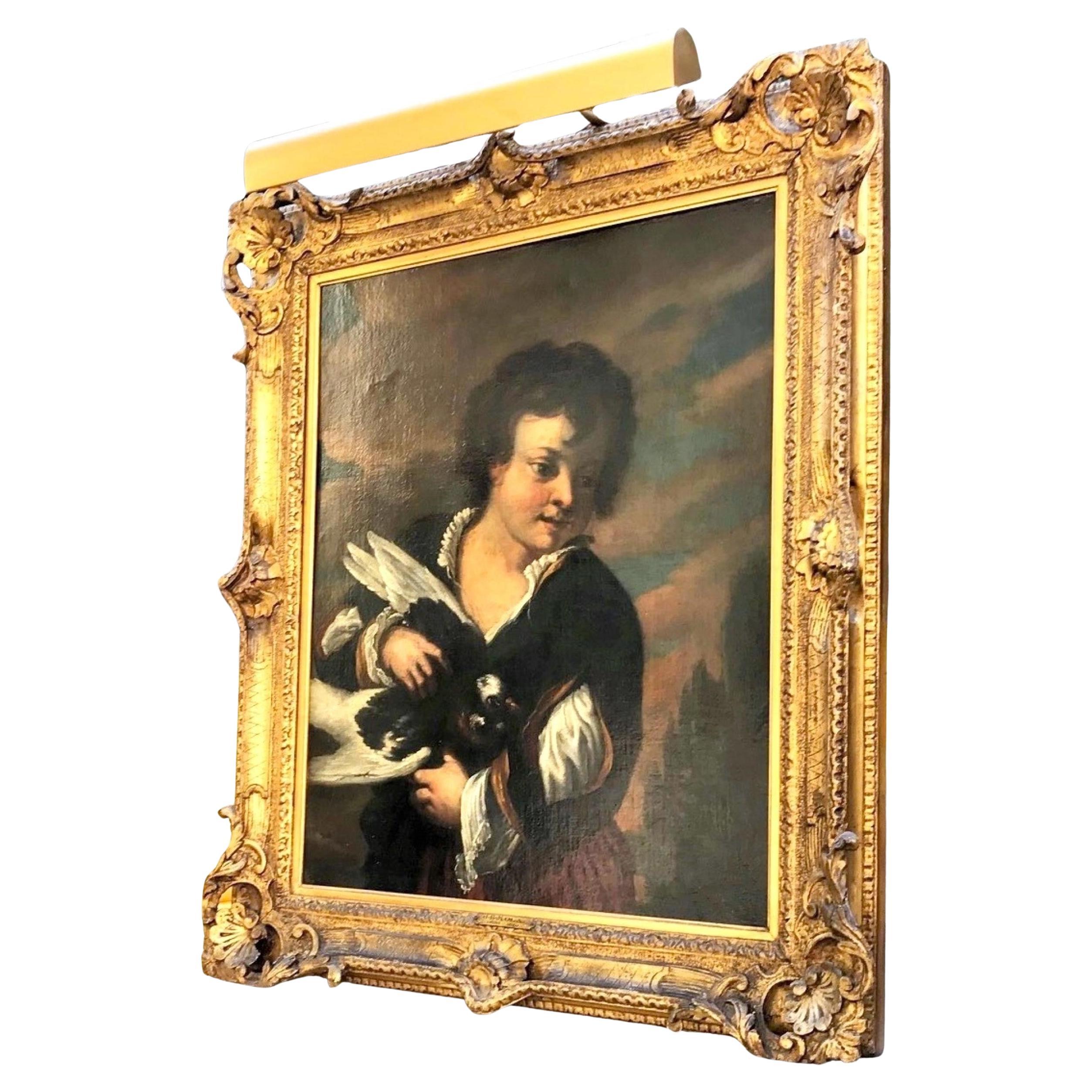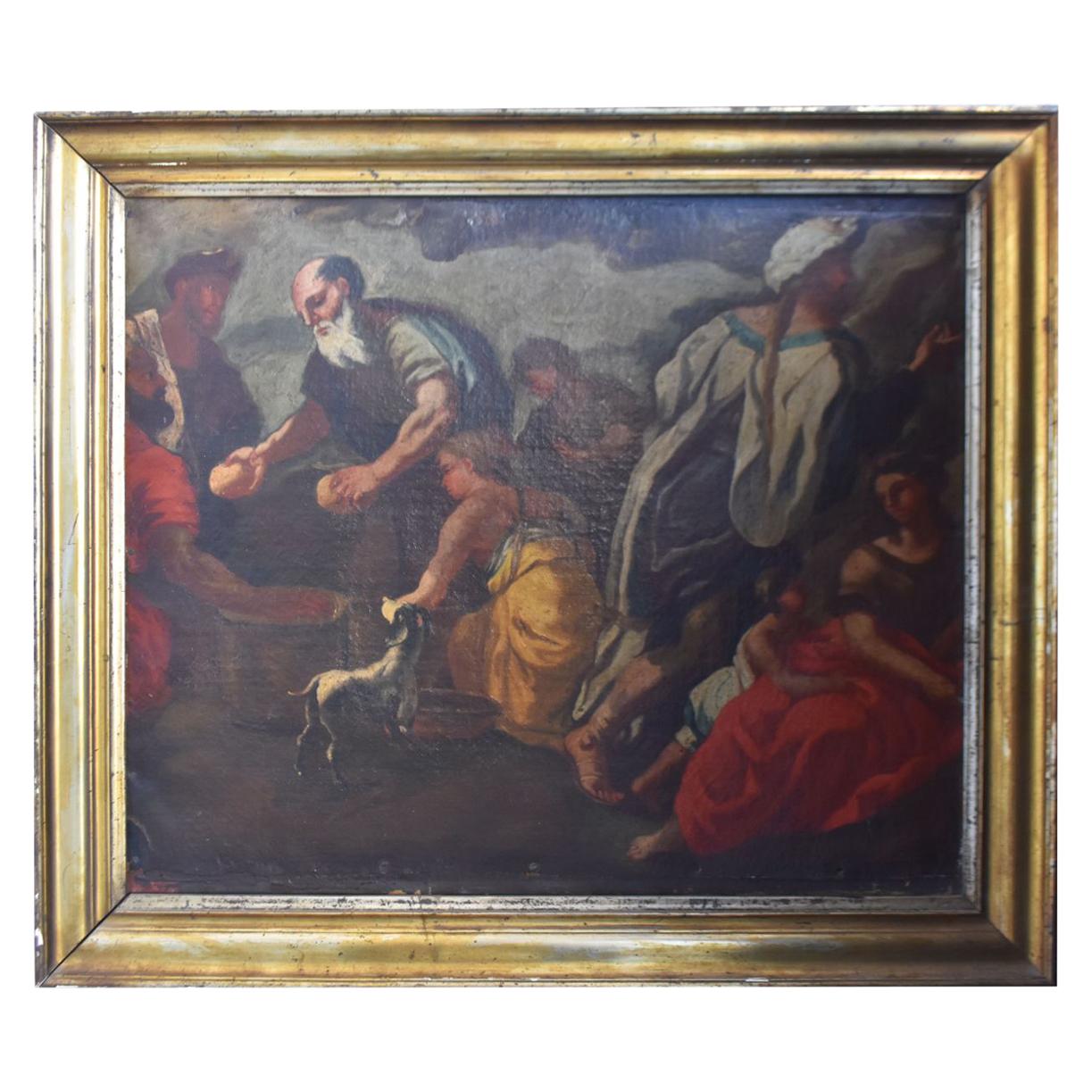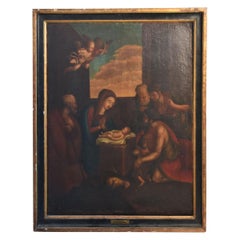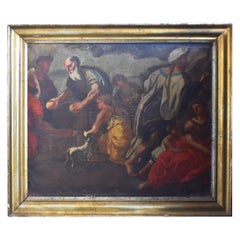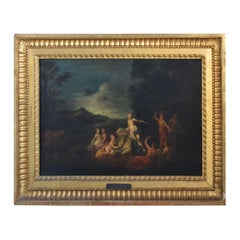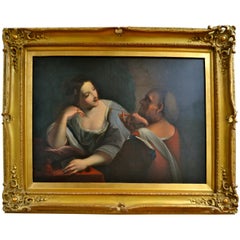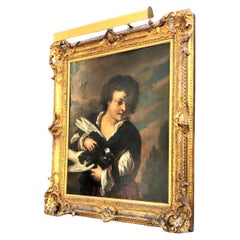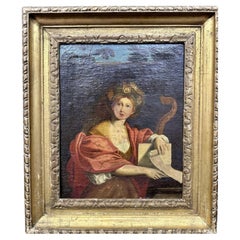Items Similar to 18th Biblical Oil on Canvas Pietro della Vecchia Aka Pietro Muttoni
Want more images or videos?
Request additional images or videos from the seller
1 of 17
18th Biblical Oil on Canvas Pietro della Vecchia Aka Pietro Muttoni
$36,100.40per set
£26,727.04per set
€30,000per set
CA$49,983.53per set
A$54,570.05per set
CHF 28,608.85per set
MX$662,774.31per set
NOK 357,277.91per set
SEK 337,365.62per set
DKK 228,396.41per set
About the Item
Oil on canvas Italian 18th century represents biblical scene: the beheading of St. Jean Baptist and the gift of his head to Salome. Obviously Caravagesque this painting is assigned to Pietro della Vecchia aka Pietro Muttoni by by the expert René Millet.
- Creator:Pietro della Vecchia (Artist)
- Dimensions:Height: 46.46 in (118 cm)Width: 54.34 in (138 cm)Depth: 11.82 in (30 cm)
- Sold As:Set of 2
- Style:Baroque (Of the Period)
- Materials and Techniques:
- Place of Origin:
- Period:
- Date of Manufacture:circa 18th century
- Condition:Minor losses.
- Seller Location:Marseille, FR
- Reference Number:Seller: 114831stDibs: LU4057312295401
About the Seller
4.4
Vetted Professional Seller
Every seller passes strict standards for authenticity and reliability
Established in 1999
1stDibs seller since 2018
81 sales on 1stDibs
Typical response time: 1 to 2 days
- ShippingRetrieving quote...Shipping from: Marseille, France
- Return Policy
Authenticity Guarantee
In the unlikely event there’s an issue with an item’s authenticity, contact us within 1 year for a full refund. DetailsMoney-Back Guarantee
If your item is not as described, is damaged in transit, or does not arrive, contact us within 7 days for a full refund. Details24-Hour Cancellation
You have a 24-hour grace period in which to reconsider your purchase, with no questions asked.Vetted Professional Sellers
Our world-class sellers must adhere to strict standards for service and quality, maintaining the integrity of our listings.Price-Match Guarantee
If you find that a seller listed the same item for a lower price elsewhere, we’ll match it.Trusted Global Delivery
Our best-in-class carrier network provides specialized shipping options worldwide, including custom delivery.More From This Seller
View All18th Century Oil on Canvas Italian School
By Carlo Maratta
Located in Marseille, FR
Painting with probably biblical Italian school characters End of the 17th beginning of the 18th century unsigned carrying a Carlo Maratta cartouche of in...
Category
Antique Early 18th Century Italian Baroque Paintings
Materials
Canvas
17th Century Italian School Biblical Scene
Located in Marseille, FR
17th century oil on canvas representation of the "Feeding of the 4,000" of Italian school.
Category
Antique 17th Century French Baroque Paintings
Materials
Canvas
19th Century Oil on Canvas José Mirailles Darmanin Spanish School
By Joseph Darmanin
Located in Marseille, FR
19th century José Mirailles Darmanin (1850-1900) Spanish school the gentleman (and his servant) takes the meal. Genre scene.
Category
Antique 19th Century French Paintings
Materials
Canvas
18th Naiads and Cow Decorated Oil on Canvas School of Coypel
By Charles Coypel
Located in Marseille, FR
18th naiads and cow decorated oil on canvas Coypel School, 18th century oil painting on canvas size: 63 cm x 43 cm, frame size: 82 cm by 62 cm.
Category
Antique 18th Century French Paintings
Materials
Canvas
Still Life Oil Painting by Arthur Chaplin
By Arthur Chaplin
Located in Marseille, FR
Still Life of Arthur Chaplin French painter born in Jouy-en-Josas in 1869, died in 1935, son of the painter Charles Chaplin. Abandoning the vaporous undressed often represented by his father, Arthur Chaplin draws inspiration beauties, most chaste, botany. Pupil of Leon Bonnat and of Bernier, his interest in the Dutch still life is confirmed on a trip to the Netherlands. He is a very talented imitator of Nature Dutch-mortistes 17th century as Rachel Ruysch...
Category
Vintage 1930s French Paintings
19th Century "The Return Of The Market" On Panel By Estachon
Located in Marseille, FR
"The return of the market" oil on panel from the 19th century by Louis Antoine Estachon 1857 Preparation of a feast based on duck, pagre, red mullet, leg of hou leek, etc.
Category
Antique 19th Century European Paintings
Materials
Wood
You May Also Like
18th Century Painting, Oil on Canvas, Italian School
Located in Toronto, CA
This is a monumental and spectacular 18th century, or possibly early 19th, oil on canvas of the Italian school. The canvas depicts a shepherd serenading a maiden in a wooded glen. B...
Category
Antique 18th Century Italian Baroque Paintings
Materials
Canvas
Italian Baroque Style Painting of Beauty and Old Age attributed to R. Manchetti
Located in Vancouver, British Columbia
An old master style 18th century allegorical painting representing youth and old age, and/or beauty and wisdom, depicted by a beautiful young ...
Category
Antique Mid-18th Century Italian Baroque Paintings
Materials
Canvas
17th C Neapolitan School Painting Oil Canvas Old Master Mola Giovanni Battista
By Molla
Located in West Hollywood, CA
17th C Neapolitan School Painting Oil Canvas Old Master Mola Giovanni Battista . Circa 1600’s important Painting Oil on Canvas painting of a boy with a bird, in original Hand carved...
Category
Antique 17th Century Italian Renaissance Paintings
Materials
Canvas, Plaster, Wood, Giltwood
$27,000 Sale Price
25% Off
18th Century Italian School "Sybile" Signed
Located in Madrid, ES
18th Century Italian School
"Sybile"
H.s.t. bears a signature,
oil on canvas
37cm x 30cm
good condition
Category
Antique 18th Century Italian Baroque Paintings
Materials
Paint
17th Century Oil on Canvas Venetian Style Landscape with Characters Painting
Located in Vicoforte, Piedmont
Antique Italian painting from the 17th century. Oil on canvas artwork depicting a landscape with figures from the Venetian school, of good pictorial quality. We see four characters a...
Category
Antique 1640s Italian Paintings
Materials
Canvas
17th Century, Italian Painting by Pier Francesco Cittadini, Jacob and his Family
Located in IT
Pier Francesco Cittadini (Milan, 1616-Bologna, 1681)
"Jacob and his family go to Egypt"
Oil on canvas, cm 109 x 190 (canvas only)
The valuable painting, made in oil on canvas, depicts Jacob and his family go to Egypt and we believe it can be, given the high quality painting, autograph work of Italian Pier Francesco Cittadini (Italy Milan, 1616 - Bologna, 1681) made after 1647. The work, in excellent condition is accompanied by a coeval frame in wood finely carved and golden.
The scene depicted, which was confused with the Flight to Egypt in the past years, is instead identified with the biblical episode of Jacob’s journey. In the foreground, reading the painting from left to right, we see a caravan composed of animals, including donkeys, dromedaries, goats, dogs and horses and people, women, men and slaves, who carry on their journey along the banks of a river, following a path that to the right, would seem to lead to the through of a bridge. In addition to the watercourse is described an environment characterized by large rocks and impervious come far to cover the entire verticality of the canvas. On the left, in the distance, we see the tail of the caravan that runs along the steep path. Large trees enliven and harmonize the environment, as well as white and grey clouds characterize the predominantly clear sky and illuminated on the right by sunlight.
The story is told in the Bible, Book of Genesis, 30, 25, passage in which is described the flight of Jacob from Haran after the contrasts with Laban, father of his wife Rachel. Jacob is the third great patriarch of the Bible. From his descendants originate the twelve generations of the people of Israel. He is the son of Isaac and Rebekah, who led him to flee from the wrath of Esau to Haran to seek refuge from his brother, Laban. At his uncle’s house Jacob met his daughter Rachel. As soon as he saw his cousin, Jacob was taken. Jacob will stay seven years in the service of Laban to marry his beloved Rachel. But Laban, with a deception, will give him in marriage first Lia, the least beautiful eldest daughter, and only after another seven years the splendid Rachel. From his first wife he will have several children, while Rachel will give birth to the beloved son, Joseph, who will become viceroy of Egypt.
After years of service, Jacob asked to be paid with every dark-coloured garment among the sheep and every spotted and dotted garment among the goats. Laban accepted and sent away from his sons all the leaders of that kind. So Jacob took fresh branches of poplar, almond and plane tree, and flayed them, and put them in the troughs. The optical suggestion induced the goats and the sheep to conceive and give birth to dark, striped and dotted garments. He also ensured that all the strongest and healthiest leaders of the flock of Laban would drink near the barked branches, thus assuring a genetic superiority to his part of the flock. His flocks grew numerous and strong and he became richer than his relative, arousing envy. It was clear that Laban would not respect him much longer. At the suggestion of the Lord, Jacob decided to return to Canaan. Trying to avoid any possible dispute, he left with his family while Laban was absent for shearing sheep. But when, three days later, his uncle returned home, he became angry, feeling offended because Jacob had gone secretly and had not allowed him to greet his daughters and grandchildren. In addition, his teraphim, statuettes, or idols, which depicted the family deities, had disappeared. After 7 days of pursuit, Laban and his men reached Jacob’s group on Mount Gilead, in the mountainous region west of the Euphrates River, where his uncle and grandson had a stormy conversation. The younger man was outraged at being accused of stealing idols and told Labano to rummage through his family’s tents at will. Neither of them could know or even imagine that it was Rachel who took the idols and hid them in the saddle of the camel. During the search, she sat down firmly on the saddle, apologizing for not being able to get up, «because I usually have what happens to women» (Gen 31:35). So the loot wasn’t discovered.
The author of this work was inspired by the composition of an engraving by Stefano Della Bella (1610-1664) of circa 1647. The engraving by Stefano della Bella bears the title "Iacob sur ses vieux jours quitte sans fascherie pour voir son filz Ioseph, sa terre et sa patrie" and is signed on the bottom left "Stef. of the Beautiful In. et fe." while on the right it is declared "Cum privil. Regis", that is with license of the king.
Stefano Della Bella (Italy - Florence, May 18, 1610-Florence, July 12, 1664) was born in a family of painters, sculptors and goldsmiths and was left early orphan of his father sculptor, he dedicated himself first to the art of goldsmith at the school of Giovanni Benedetto Castiglione and Gasparo Mola, then turning his attention to drawing and engraving. He soon began drawing figures and copying the etchings of Jacques Callot, which inspired his early works. Under the protection of the Medici, in particular of Don Lorenzo, cadet son of Grand Duke Ferdinand I, Della Bella has the opportunity to make study trips to Rome, where he stayed from 1633-1636; In Rome he met French engravers and publishers of prints such as Israël Henriet and François Langlois, who influenced his decision to move to Paris in 1639, four years after the death of Callot. In Paris he soon reached, thanks to the engravings commissioned by Cardinal Richelieu, the success also worldly; he frequented courtiers, theatre artists and writers, while refusing too oppressive honors. In 1646-1647 he continued his travels in the Netherlands to Amsterdam, Antwerp and Dordrecht. He returned to Florence in 1650 and resumed working under the protection of the Medici court, working for his patrons. In 1656 he became a member of the Academy of Apatists.
The painting object of this study is reasonably attributable to Pier Francesco Cittadini, or Pierfrancesco Cittadini, called the Milanese or the Franceschino (Italy - Milan, 1616-Bologna, 1681) as some exemplary stylistic comparisons proposed to follow can prove.
Pier Francesco Cittadini was an Italian baroque painter, mainly active in Bologna.
His artistic training first took place with the painter Daniele Crespi...
Category
Antique Mid-17th Century European Baroque Paintings
Materials
Canvas, Giltwood
More Ways To Browse
Oil Painting Biblical
Dutch Biedermeier
Framed Coat Of Arms
French Renaissance Painting
Horse Wood Frame
Mcm Oil Painting
Modern Abstract Scandinavian Paintings
Vernet Claude Joseph
19th Century French Seascape Paintings
Antique Copper Still
Antique Oil Painting Ships
Antique Persian Miniatures
Art Deco Bathers
Chimney Sweep
Coat Of Arms Painting
Danish Artist Landscape
English Oil On Canvas Horse
Flower Danish Painting
